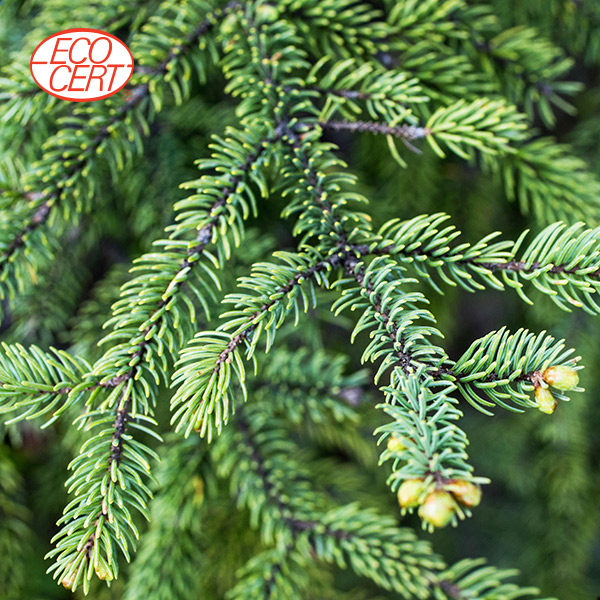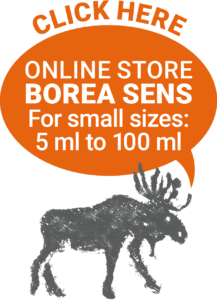BLACK SPRUCE Twigs & Needles Essential Oil

Latin name: Picea mariana
French Name: Épinette Noire
English Name: Black Spruce
Botanical family: Abietaceae or Pinaceae
Origin: Canada
Harvest time: January to December
Plant/part used: Fresh twigs & needles
Components: Bornyl acetate, camphene, α-pinene , δ3-carene , β-pinene
Organoleptic Properties: Clear and colorless with the smell of fresh conifer, the soft resin is almost icy, slightly spicy with hints of citrus.
Materials and methods: Essential oil is extracted through a process of steam distillation. Fresh twigs and needles are collected from the Picea mariana throughout the year in the region of Eeyou Istchee James Bay.
CANADA, NORTH OF QUEBEC PROVINCE
A LONG TRIP TO BLACK SPRUCE IN BOREAL FOREST
To reach the Black Spruce in Boreal Forest, where it is distilled, the tourist might say that it is as far as going to SAINT-FAR-AWAY-OF-SO-FAR NORTH!
BOREAL FOREST
The Canadian Boreal Forest spans more than 3 million square kilometres and cover close to 60% of the Canada, from east to west and mainly north of the country. The majority of which is unaffected by human activity (road, cities, industries). The dominant tree species are: black spruce, jack pine, balsam fir, white spruce and larch. There are also a broad diversity of other plants, like the well-known blueberry and Labrador tea.
The Quebec government, through its Ministry of Forests, Wildlife and Parks (MFFP), manages and controls its exploitation through a precise and rigorous legal framework involving all the actors of the forest (forestry companies, first nations, other residents, tourism, distillers, etc.). This allows for the control of the human impact on the forest while assuring the sustainability of the resource and a mostly natural regeneration of the forest.
After serious problems with extensive clear cuts in certain areas during the 1990’s, provinces such as Quebec reached agreements with First Nations, known as the Paix des Braves to change policies and practices toward sustainable forest management (The Grand Council of the Crees, 2002) Moreover some forest management units/logging companies are now Forest Stewardship Council (FSC) certified and practice smaller, mosaic cutting based on the Paix des Braves policies.
So that today, operations to extract essential oil from Black Spruce in the boreal forest are in synergy with nature, the existing government framework and all other actors in order to be in harmony with the entire ecosystem.
ORIGIN
Black Spruce is a majestic conifer ranging in height from of 8 to 25 meters. These trees look after our Canadian forests from coast to coast, because this conifer grows where other species cannot grow. Favoring moist, sandy or peaty soils, this tree covers North America mainly from Canada’s Far North to the edge of the low Arctic tundra, as well as the northeastern United States. Its twigs are rough and its frayed bark is reddish brown when young and darker when mature. Its greyish-green needles are straight and tight along its branches. Its fruit is a small purple cone that changes to light brown. Of the forty varieties of spruce, it is the most resistant to very cold climates. It can withstand up to -60 degree Celsius temperatures according to some studies. Without its biggest enemy, which is fire, this tree could live up to 280 years.
HISTORY
Native people have been using many medicinal plants from the boreal forest for thousands of years for healing purposes. This knowledge is generally held as a form of oral tradition. Cree from the woodlands used Black Spruce as an anti-diarrheal medication by making infusions from the cones. At other times the needles and cones were used to treat diabetes. For burns, they made balms from Black Spruce resin and chewed on cones to relieve toothache.
The Montagnais First Nations from the Quebec Province used Black Spruce to prepare infusions against sore throats and to cure coughs. Native American children chewed the resin to improve the whiteness of their teeth. They attributed to Black Spruce powerful properties against scurvy. Used mainly to build settlers’ homes, the tree was also used to brew spruce beer made from: needles, cones and molasses. Under the pretext of preventing scurvy, this drink flowed freely in the evenings with the clergyand on board ships!
In 1772, the English physician, Henry Taylor, discovered a method to extract the essential oil from the spruce and recommended it for respiratory diseases. Dr. Taylor is also the founder of the first distillery in Québec City.
KEY BENEFITS
Black Spruce essential oil to help your energy metabolism and your body. In synergy with Pine Scots essential oil, it helps the endocrine system. It is welcome from premenopause. Apply a few drops in the morning to the adrenals and lower back to help fight fatigue and fatigue.
Its anti-inflammatory property accompanies you in cases of rheumatoid arthritis, inflammation of the Achilles tendon, sciatic nerve, sprains and others. Just gently massage a few drops of Black Spruce and Wintergreen mixed with St. John’s Wort oil on the affected area, 2 to 3 times a day for pain in the lower limbs.
Essential oil aromatherapy properties:
- Circulatory system: cardiac antispasmodic, tonic of the lymphatic system.
- Skin system: anti-inflammatory at the initial stage, brings sedation, relaxation and soothing, antibacterial. Dry acne and eczema, purulent acne, scabies, cutaneous parasitosis
- Digestive system: appetite stimulant, digestive, eupeptic affect, stomachic, intestinal antispasmodic with analgesic action, antifungal, relax solar plexus knots. Systemic yeast infections (candida), anti-parasite (Giardia lambia, hookworms)
- Endocrine system: mimetic cortisone (hypophyso-cortico-adrenal axis and pituitary-ovarian axis) Hot flashes, fatigue of the adrenal glands, asthenia.
- Immune system: aerial antiseptic, antifungal, antibacterial, antiviral, antiparasitic, adrenal gland tonic. Immunodeficiency.
- Respiratory system: bronchial antispasmodic, pulmonary decongestant, antioxidant, bronchial anti-inflammatory, mycobacterium of tuberculosis, antitussive and expectorant. Bronchitis, cold, sinusitis, cough, asthma.
- Nervous system: relaxing, neurotonic, regulates serotonin (the happiness hormone). Promotes sleep and calms chronic pain.
- Osteo-articular system: anti-inflammatory, analgesic, decongestant, arthrosis, muscular rheumatism, fibromyalgia.
- Genitourinary system: spasmolytic for knotted pelvic and sacral plexus, inflammatory prostatitis.
PSYCHIC
Releases serotonin: this has the effect of acting as a natural antidepressant, increasing the feeling of well-being and inner calm and increasing empathy.
Psycho-tonic anxiolytic
Contra-indications: avoid use during the first three months of pregnancy and in cases of thyroid or adrenal disorders; long-term pure topical application may cause redness if the product is oxidized.
Recommendation: Essential oils are wonderful for the well-being of humans, animals, insects and plants. There are many books that discuss aromatherapy and you should refer to them for proper and safe use. We also recommend that you consult a professional in aromatherapy who will be able to target the biochemical groups and aromatic molecules of essential oils and thus increase the effectiveness of your care.
Essential oils should be stored in a cool, dry place, protected from light and air.
The information provided on this website is NOT a recommendation of a cure or the treatment of a medical condition or disease.
VIDEOS
References
- Festy Danièle, Ma bible des huiles essentielles, Guide complet d’aromathérapie, Montréal, Éditions Caractère, 2009.
- Site officiel : Ressources naturelles Canada.
- Franchomme, P., Jollois, R,. Pénoël, D., L’aromathérapie exactement, Encyclopédie de l’utilisation thérapeutique des huiles essentielles, fondements, démonstration, illustration et applications d’une science médicale naturelle, Bayeux, Éditions Roger Jollois, 2001. Hydrosols : The Next Aromatherapy, 2001.
- http://www.wikiphyto.org
- Frère Marie-Victorin, Rouleau Ernest, Brouillet Luc et collaborateurs, Flore laurentienne 3e édition, Gaëtan Morin Éditeur ltée, 2002.
- Moerman Daniel E., Native American Ethnobotany, Timber Press, Portland, Oregon, 1998.
- Mathieu Jacques, L’annedda, l’arbre de vie, Québec, Les Éditions du Septentrion, Les cahiers du Septentrion, 2009.
- Werner Monica, Von Braunschweig Ruth, L’Aromathérapie, Principes, Indications, Utilisations, Paris, 2007.
- Baudoux Dominique, L’Aromathérapie, Se soigner par les huiles essentielles, Bruxelles, Edition Amyris, Douce Alternative.
- Schafer, D. and W. Schafer (1981). “Pharmacological studies with an ointment containing menthol, camphene and essential oils for broncholytical and secretolytical effects.” Arzneimittel-Forschung/Drug Research 31(1): 82-86.

